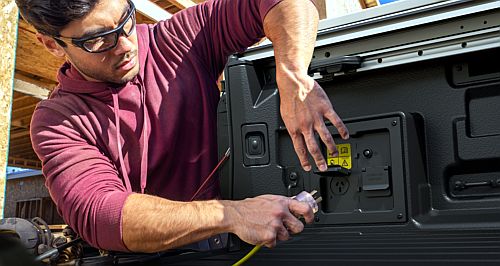Make / Model Search
News - General News - Electric VehiclesV2G tech to assist renewable power suppliesARENA and Amber Electric to trial electric vehicle smart charging, vehicle-to-grid services4 Jul 2024 By MATT BROGAN THE Australian Renewable Energy Agency (ARENA) has contributed $3.2 million to funding Amber Electric’s electric vehicle smart charging and vehicle-to-grid (V2G) optimisation project.
Aimed at realising financial savings for electric vehicle owners, the three-year trial will see 1000 participants use and sell energy at times that are beneficial for the grid, and ultimately the environment.
Amber Electric says learnings gained through the trial and its participants will inform policy across Australia and encourage other industry participants to follow suit.
The provider will contribute a further $4.5 million to the ARENA-supported project (for a total of $7.7m) in a bid to show at scale that the pairing of EVs directly with the wholesale electricity market creates the incentives needed for people to use their own cars to buy and sell energy.
The Australian Energy Market Operator (AEMO) predicts Australia will need 18GW of battery capacity by 2030 to “close the gap” between when renewable energy is being generated and when it is most needed.
Amber Electric’s trial aims to demonstrate that so-called “batteries on wheels” can provide the energy storage capacity needed stating that bidirectional EV charging is potentially one of the largest and lowest-cost sources of energy storage.
The company told GoAuto that while only a small number of vehicles and charging equipment currently offer V2G capabilities – not to mention their use being restricted to certain approved sites and trials in South Australia at the moment – the expected growth of V2G technology and availability of compatible vehicles means the trial has come at just the right time.
“At present, only a handful of BEVs have V2G and bidirectional charging capability. On top of this, there are only a few chargers that are compatible with these V2G-capable vehicles, and this is likely to continue into the immediate future,” said Amber Electricity spokesperson Valentina Garcia.
“However, we do expect that a lot more car manufacturers will enable V2G and more chargers with CCS technology to become available.”
Ms Garcia explained that the ultimate success of the trial will be reliant on three pillars.
Firstly, the vehicles and chargers, with more of each expected to offer the relevant technology over the years ahead.
Secondly, the standards, which are yet to catch up to the technology for bi-directional chargers, and need to be updated to allow inverter manufacturers to bring products to market that can support V2G models.
Finally, the network itself. Currently, each site requires the submission of a connection approval. To date, this process is being led by South Australia with “a couple of sites” in New South Wales currently invested in the process.
“In summary, there are current limitations regarding hardware (charger) and car compatibility and availability, as well as regulatory frameworks including Australian standards and approvals for networks that need to happen in order for V2G to become scalable,” added Ms Garcia.
“At the moment we are still scoping out hardware (charger) options for the trial given how nascent V2G technology is at present.”
Amber Electric co-CEO Dan Adams described V2G as “a transformative leap for energy storage in Australia, and the energy system as a whole”.
“By integrating electric vehicles with the grid and the wholesale energy market, we can reduce costs for consumers whilst accelerating the transition to renewable energy.
“Our customers will be able to directly compete with big coal and gas generators just by smart charging and discharging their EV battery. This innovation not only strengthens our energy infrastructure but also aligns with a commitment to a sustainable future.”
Mr Adams said a typical EV battery can store enough energy to power an average home for up to five days.
With the advent of bi-directional charging capabilities, he claimed the potential to put energy back into the grid means that as many as five million “batteries on wheels” could be in Australian homes and driveways by the end of the decade – equivalent to approximately 30GW of battery capacity.
The trial will take place across the Australian Capital Territory, New South Wales, Queensland, South Australia and Victoria over the next two years with the V2G scope expected to kick off in mid-2025.
“With the accelerating uptake of electric vehicles in Australia, this project will develop and demonstrate new ways for consumers to unlock value from their consumer energy resources and facilitate greater use of renewable energy,” said ARENA chief executive office Darren Miller.
Since 2020, ARENA has announced grant funding of $97.4 million towards the decarbonisation of transport including public charging infrastructure, fleet decarbonisation and innovation in charging.  Read more27th of June 2024  Rivian and Volkswagen strike software dealJV to centre on software defined vehicle development aiding speed to market for both26th of June 2024  Hydrogen a longer-term target: BMWFuel-cell electric vehicles will supplement EVs, offer alternative for towing, longer distances19th of June 2024  Fisker files for bankruptcyAmerican EV manufacturer Fisker files for Chapter 11 bankruptcy protection18th of June 2024  Hydrogen HiLux reaches final test phaseFinal testing phase for hydrogen fuel cell HiLux with real-world trials underway14th of June 2024  GM scales back EV investmentGeneral Motors will build 50,000 – 100,000 fewer EVs this year as demand wanes |
Click to shareGeneral News articlesResearch General News Motor industry news |











Facebook Twitter Instagram